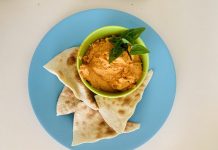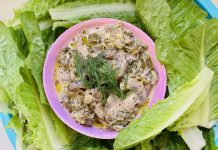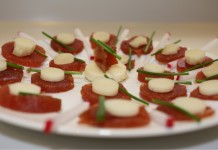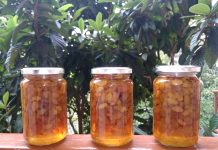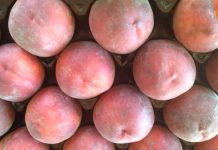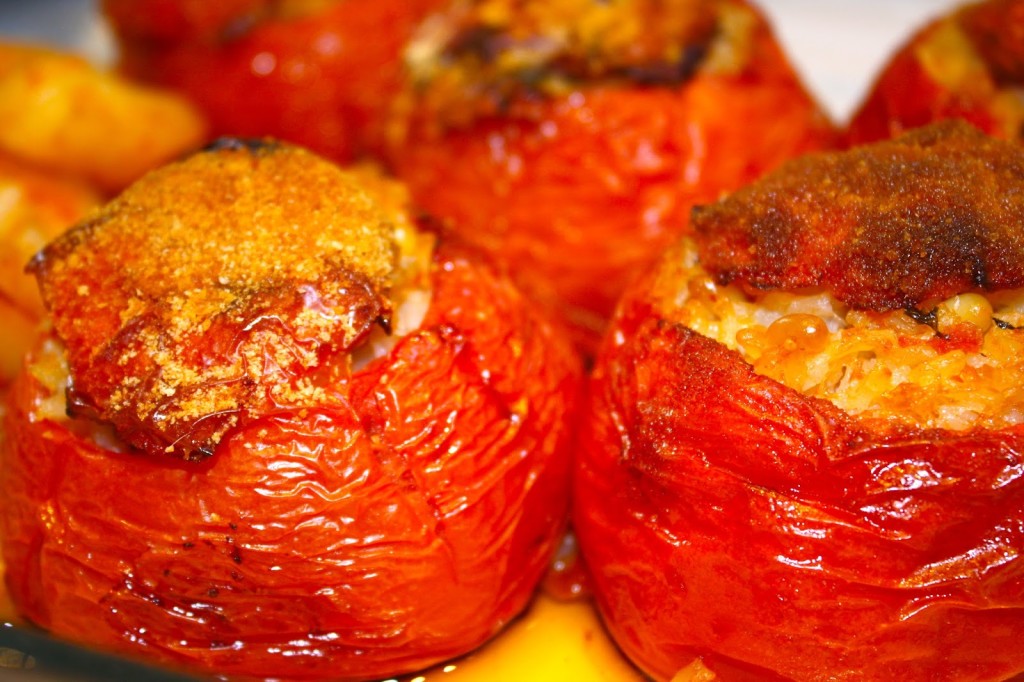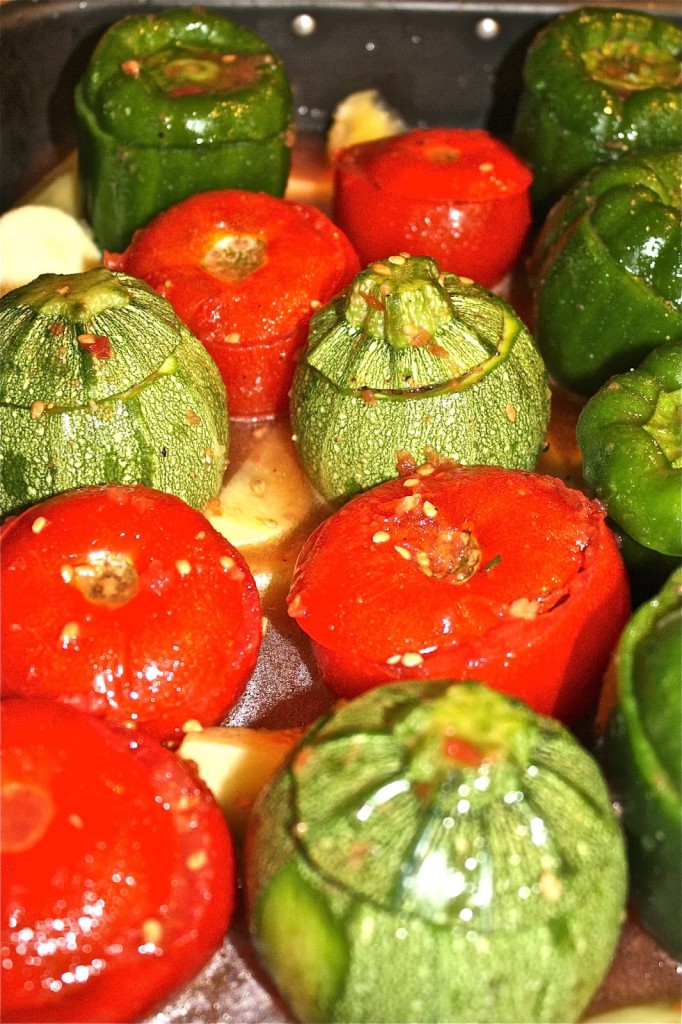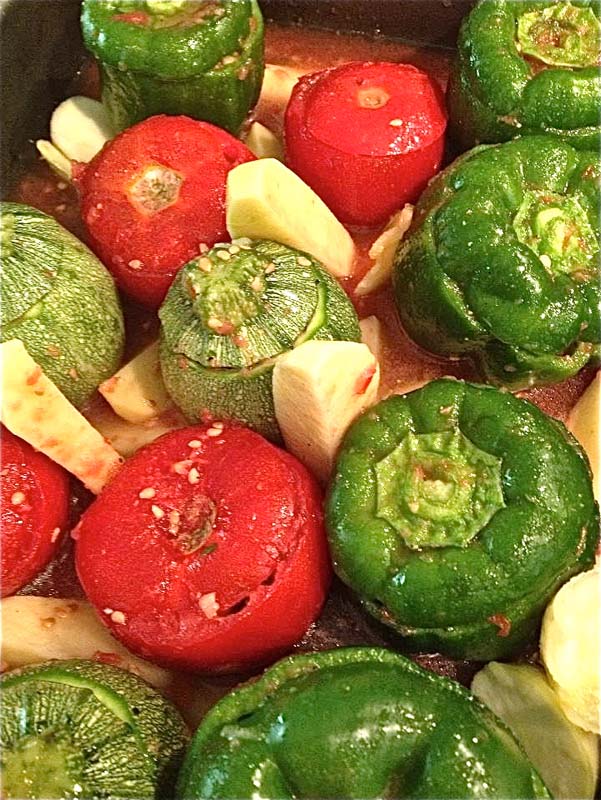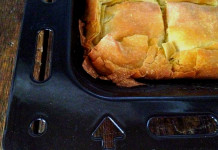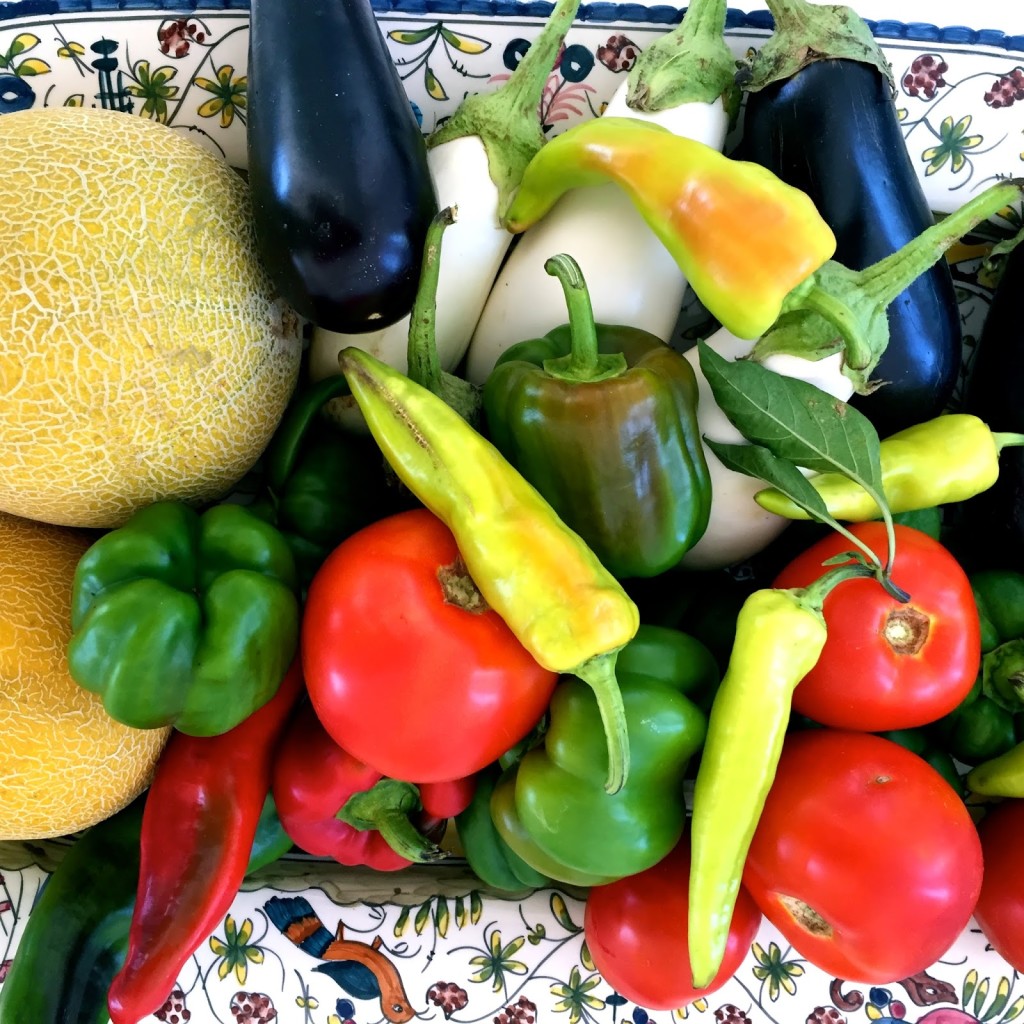 It is the same story every beginning of the summer : I am eagerly waiting for the first tasty and somewhat ripe tomatoes and peppers so I can cook one of the greek foods I love the most : gemista (stuffed vegetables)!
It is the same story every beginning of the summer : I am eagerly waiting for the first tasty and somewhat ripe tomatoes and peppers so I can cook one of the greek foods I love the most : gemista (stuffed vegetables)!
As I prepare to empty them and make the filling , I stop and stare for a few minutes at their gorgeous summer colors, the bright tomato red, the dark green of the peppers as if I am paying tribute to the three generations of my family’s cooks that have been each serving gemista in their very own way. I am the representative of the third generation , with my oldest daughter who adores gemista next in line. I cannot help it but wonder what her twist on gemista will be…
Let me explain : my grandmother , some seventy years ago, filled them with short-grain rice(similar to the rice used for risotto), loads of parsley and some spearmint. Simple and tasty. But the thing I remember the most from her recipe is the amazing taste of the tomatoes and peppers. I don’t know if I’ve eaten tastier vegetables since, all hand-picked from her garden, the tomato delicious, sweet and intense, the pepper crunchy, elegant and, well, yes, peppery to balance out the sweetness of the ripe tomato!
I think back and wonder where have all these wonderful little vegetable gardens disappeared to – because each greek home had one, even in the cities, with apricot trees, tomatoes and peppers, lots and lots of easy to grow courgettes, crawling small strawberry plants, edible flowers and herbs in small clay pots, perhaps a hen or two, or even a rooster…everything a household needs to be independent and adequately cover its daily nutritional demands while showing respect to our food-growing planet. The modern permaculture notion is very similar to that old way of tending a vegetable garden which not only made people aware of environmental issues but also happy for watching their own food grow.
My mother, on the other hand, fifty-so years ago, cooked her stuffed vegetables with parboiled, long grain rice (believe it or not, during her times even which kind of rice you used was a matter of class, as long rice was more expensive and fancier than the short glutinous rice)! She also added , with the rice, a spoonful of minced meat in each so we could be eating some animal protein even on ‘vegetarian’ days, a sign of a wealthier society perhaps. What I remember most from her recipe is that during our summer holidays she would prepare the food very early in the morning and send it to the village bakery to be cooked , not all houses had electric ovens back then and ours , a -rented- one, neither ! I also remember that my cousin and I were assigned to pick up the food at lunchtime. I can still picture the three of us on his bicycle – my cousin, me and…the tray of stuffed vegetables under the scorching noon sun , riding and laughing our hearts out with the balance required from bicycle driver and passenger/food carrier alike! We’d often stop not so much as to rest but to savor a yummy potato with drops of the sauce spilling over and staining our flip flops… Ah, yes…and the fine breadcrumbs on top of every tomato and pepper that my mom had added, her gemista looked prettier than my grandma’s. I remember that, too…
And finally me, a genuine representative of globalization where food is a mix-and-match of old and new, Western and Eastern flavors, traditional and modern cooking methods and techniques, traditions forgotten at a faster rate than expected. As a result, I usually cook my stuffed vegetables without meat and with a twist of eastern spices, influenced by my travels and the cookery books I have read.
So, I use tomatoes and peppers, but also large courgettes. I fill them with mixed rice (brown and wild for more nuttiness and extra fiber), blond sultanas or black greek raisins, lots of spices and herbs as well as the traditional aromatic mint and parsley, lightly toasted pine nuts and grated carrots and courgettes.
I also add lots of potatoes in the baking tray because they are truly scrumptious and are the first to ‘disappear’ as soon as the food is placed on the table…as a ‘starter’, with a little salty feta, which is the best accompaniment for all summer traditional dishes with no exception but the fish.
In my version, apart from the olive oil I use to bake the gemista, I make sure I use a good extra virgin olive oil and add a few drops on each vegetable before serving, along with the wonderful sauces from the baking tray.
Three Generations of Gemista
(Greek Vegetarian Stuffed Vegetables)
Preheat the oven at 200C/400F.
Roast the pine nuts in the warming oven until they’re lightly golden. Remove and keep nearby.
Wash the tomatoes, peppers and courgettes well.
Soak the brown and wild rice for an hour (or overnight) in warm water.
With a sharp knife, cut a horizontal slice at the very top of each vegetable, just under where the stem is.
Remove the ‘lids’ of all the vegetables with care and place them next to their accompanying vegetable, so you remember which lid belongs to which tomato or pepper.
Scoop out the flesh of the tomatoes with a knife or teaspoon, making sure not to rupture the sides.
Add a pinch of salt and sugar in the cavity of each vegetable .
Cut the large courgettes in two and empty each half using a small spoon or the special tool, but without reaching the bottom – the courgettes must be able to stand on the tray. Remember to also cut a small slice that will serve as a lid.
Place the vegetables in a well-oiled tray, making sure there’s a little space for the potatoes (cut in wedges) to snuggle in between the vegetables.
Dice the onions , mince the garlic -if using- and grate the carrots.
In a wide skillet with half a cup of extra virgin olive oil add the rice (2 tablespoons per vegetable) , the flesh you removed from the courgettes , the grated carrots and half from the tomatoes flesh.
Saute the mix and then continue to cook until the rice is still hard to the tooth and then start adding water, a little at a time, until the rice is cooked al dente.
Add the raisins or sultanas (a large handful for all the vegetables), and near the end, add the pine nuts.
Stir on a low heat until the filling is quite dry.
Remove from the fire and add a handful of each chopped parsley and spearmint, salt and plenty of pepper.
Cut the potatoes in thick wedges and place in a bowl. Salt and pepper them, add the remaining tomato flesh, a bit of olive oil and mix well.
Fill the vegetables with the rice mixture and cover with each corresponding lid.
Place the potatoes so as to stand between the vegetables and pour the remaining juice on all the vegetables.
Cover the tray with aluminum foil and bake for an hour.
Take the silver foil off and let it bake for another hour at 180C/360F, adding a minimal amount of hot water if you notice the sauce evaporating too fast.
When they’re ready, remove the stuffed vegetables from the baking tray and place in the serving platter – even though it’s not always necessary to remove them from the rustic beauty of the tray…
Sprinkle some of your best olive oil on top.
‘Pinch’ a potato…or two…you deserve it! Stuffed tomatoes aren’t an easy dish to prepare, but they’re the epitome of Greek summer food and, as such, demand only the most exceptional vegetables! Never compromise on that!
P.S. Always serve gemista with a tangy greek feta and a good loaf of rustic fresh bread.
Kali orexi!


